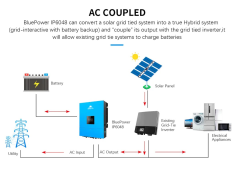I have a grid tied 8.4KW system (with APSystems microinverters) and want to add batteries to use during times when the sun doesnt shine
I have 45KWh of batteries (LiFePO4) and the sungoldpower ip6048 inverter. I selected this inverter since it can do ac coupling
My power usage is peak 8KW but typical only 2KW (I live in a hot place)
My plan was to wire the system like shown in the picture. My guess was that
- During the day when the sun is shining and full generation
Solar generation (8.4KW) feeds into home (2KW) and rest to charge batteries
When batteries are full, feed the remaining power to the grid
- During the day when the sun is not shining as much, or during the night
Solar generation (say 0KW or 1KW) feeds into home
Grid supplies additional power for use
- During peak summer months, same like day when sun isnt shining as much
Main points of confusion
- The inverter says peak 6KW, so does that mean that it can pass through the remaining (upto 8KW during hot nights) from the grid, and not trip
- If I have time-of-use metering (say free nights), can I turn off the battery use at 8pm and consume all the power from the grid
Thank you very much in advance
I have 45KWh of batteries (LiFePO4) and the sungoldpower ip6048 inverter. I selected this inverter since it can do ac coupling
My power usage is peak 8KW but typical only 2KW (I live in a hot place)
My plan was to wire the system like shown in the picture. My guess was that
- During the day when the sun is shining and full generation
Solar generation (8.4KW) feeds into home (2KW) and rest to charge batteries
When batteries are full, feed the remaining power to the grid
- During the day when the sun is not shining as much, or during the night
Solar generation (say 0KW or 1KW) feeds into home
Grid supplies additional power for use
- During peak summer months, same like day when sun isnt shining as much
Main points of confusion
- The inverter says peak 6KW, so does that mean that it can pass through the remaining (upto 8KW during hot nights) from the grid, and not trip
- If I have time-of-use metering (say free nights), can I turn off the battery use at 8pm and consume all the power from the grid
Thank you very much in advance



